Introduction to Django Allauth
Django provides different types of features to the user, in which that allauth is one of the features that Django provides. Allauth is an integrated collection of Django applications. In other words, we can say that it is used to provide authentication, registration, and management of accounts over the different integrated applications of Django. It also offers third-party account authentication features. Django accompanies a powerful implicit validation authentication framework for clients, yet it doesn’t provide help for outsider (social) confirmation using administrations like Github, Gmail, or Facebook.

What is Django Allauth?
In the existing Django applications, we already address the social validation center on only that. You usually need to coordinate another application to help with verification using a nearby record.
This approach isolates the universes of nearby and social verification. Be that as it may, there are normal situations to be managed in the two universes. For instance, an email address passed along by an OpenID supplier isn’t destined to be confirmed. This way, the email address should be checked before connecting an OpenID record to a neighborhood account. In this way, email confirmation should be available in the two universes.
Incorporating the two universes is a seriously monotonous interaction. It is certainly not a question of adding one social verification application and one nearby record enrollment application to your INSTALLED_APPS list. This is the explanation for this venture began – to offer a wholly incorporated confirmation application that considers both neighborhood and social validation with streams that work.
Setup Django Allauth
Now let’s see how we can do allauth setup on Django as follows:
Django accompanies a robust underlying verification framework for clients; however, it doesn’t offer help for outsider (social) confirmation through administrations like Github, Gmail, or Facebook. Luckily, the fantastic outsider Django-allauth bundle does this in only a couple of steps.
So first, we need to create a new directory called sampleproject, and inside the directory, we need to install Django with Pipenv. After that, we need to start the new Django project that accesses the top-level directory name. Now, wait for migration; once the process is completed, run the runserver command to start the Django local web server. All the above commands, as shown in the screenshot as follows.
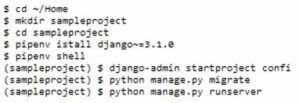
After, we need to hit the request IP to see the default Django webpage, as shown below.
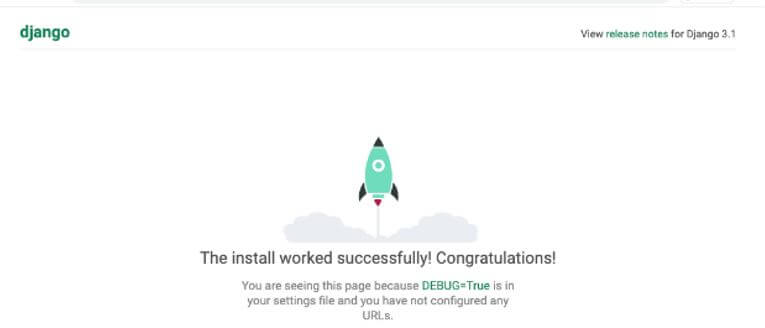
We need to install the Django allauth and configure the newly created project, so installation uses the below command.
Code:
(sampleproject) $ pipenv install django-allauth==0.43.0After completing the installation, we need to update our setting file, so first, open the setting.py file and add the following line.
Code:
INSTALLED_APPS = [
'django.contrib.admin',
'django.contrib.auth',
'django.contrib.contenttypes',
'django.contrib.sessions',
'django.contrib.messages',
'django.contrib.staticfiles',
'django.contrib.sites', # newly added line
'allauth', # newly added line
'allauth.account', # newly added line
'allauth.socialaccount', # newly added line
'allauth.socialaccount.providers.github', # newly added line
]Now at the bottom of the settings file, we need to mention allauth, so add an Id that uses allauth and configure. After that, we can redirect to the home page.
Code:
AUTHENTICATION_BACKENDS = (
"django.contrib.auth.backends.ModelBackend",
"allauth.account.auth_backends.AuthenticationBackend",
)
ID = 2
ACCOUNT_EMAIL_VERIFICATION = 'none'
LOGIN_REDIRECT_URL = 'index'So here, we installed all the packages of allauth, so we need to add the required URLs by using the following code.
Code:
from django.contrib import admin
from django.urls import path, include
url = [path]We need to migrate all changes to the existing database with the help of the below command.
Code:
(sampleproject) $ python manage.py migrateGithub OAuth
OAuth is an open norm for verification between frameworks. When clients sign into our site with their Github account, we will divert them to Github, which then sends us a symbol that addresses the client.
We need to visit the official URL below for a configuration with the new OAuth.
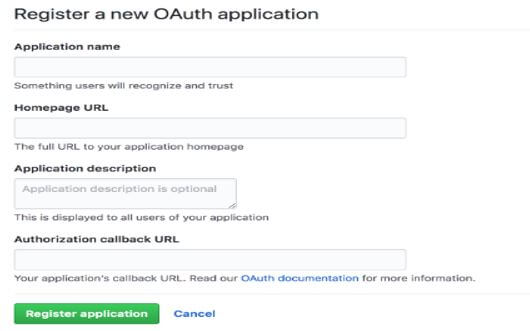
So here, we need to fill in all the details and click on the register application button.
Django Allauth Admin
In the next step, we need to configure the Django admin file, so first, we need to create a new super admin user with the help of the below command so that we can log in.
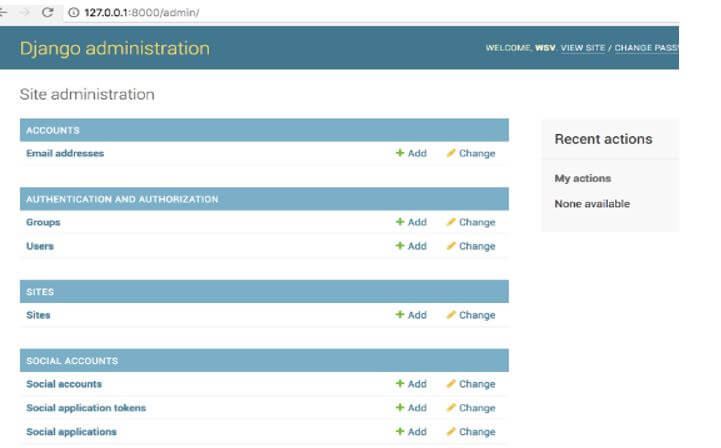
Here we need to update allauth with the specified domain name, which is visible for admin, as shown in the below screenshot.
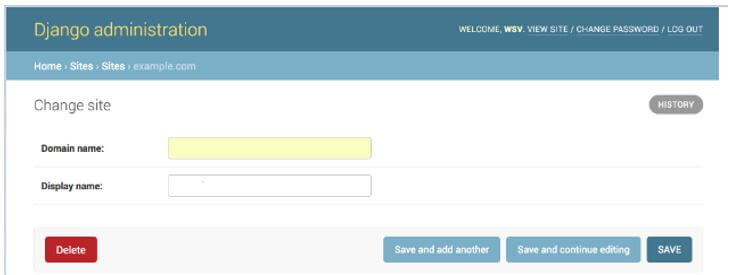
Now go to the home page, click on Social Application for configuration, make necessary changes, and return to the home page.
Django Allauth Configuration
Now let’s see how we can configure the allauth in Django as follows:
Most Django-allauth highlights can be arranged utilizing the underlying connectors and factors by putting them in settings.py. document. Although the documentation has many choices with great clarifications, it features a few significant ones underneath.
- Email affirmation expiry: Sets the number of days inside which a record should be actuated.
Eg: ACCOUNT_EMAIL_CONFIRMATION_EXPIRE_DAYS=6
- Email expected for enactment: This choice permits you to set whether the email address should be expected to enroll. Set False to handicap email necessity.
Eg: ACCOUNT_EMAIL_REQUIRED = True
- Account email confirmation: This choice can be utilized to set whether an email check is essential for a client to log in after enrolling in a record.
- Login Attempt Limit: This setting needs to be utilized with the ACCOUNT_LOGIN_ATTEMPTS_LIMIT setting.
- Login and Logout URL: When the client signs in or logs out, you should divert the client to a specific URL or page; the underneath settings can be used to set those qualities. Of course, allauth diverts login to/accounts/profile/URL and log out to the localhost:8000 or any localhost landing page.
As shown in the below screenshot.

Conclusion
With the help of the above article, we saw Django allauth. From this article, we saw basic things about the Django allauth, the features and installation of the Django allauth, and how we use it in the Django allauth.

